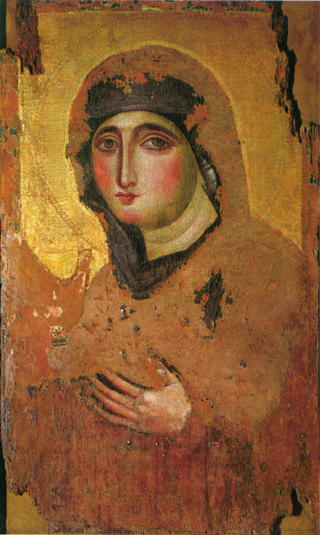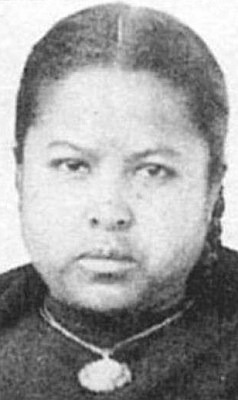Related Research Articles

All Souls' Day, also called The Commemoration of All the Faithful Departed, is a day of prayer and remembrance for the faithful departed, observed by certain Christian denominations on 2 November. Through prayer, intercessions, alms and visits to cemeteries, people commemorate the poor souls in purgatory and gain them indulgences.

In religious belief, a saint is a person who is recognized as having an exceptional degree of holiness, likeness, or closeness to God. However, the use of the term saint depends on the context and denomination. In Catholic, Eastern Orthodox, Anglican, Oriental Orthodox, and Lutheran doctrine, all of their faithful deceased in Heaven are considered to be saints, but some are considered worthy of greater honor or emulation. Official ecclesiastical recognition, and consequently a public cult of veneration, is conferred on some denominational saints through the process of canonization in the Catholic Church or glorification in the Eastern Orthodox Church after their approval.

Mary was a first-century Judean woman of Nazareth, the wife of Joseph and the mother of Jesus. She is a central figure of Christianity, venerated under various titles such as virgin or queen, many of them mentioned in the Litany of Loreto. The Eastern and Oriental Orthodox, Church of the East, Catholic, Anglican, and Lutheran churches believe that Mary, as mother of Jesus, is the Mother of God. Other Protestant views on Mary vary, with some holding her to have considerably lesser status.

The Hail Mary or Angelical salutation is a traditional Catholic prayer addressing Mary, the mother of Jesus. The prayer is based on two biblical passages featured in the Gospel of Luke: the Angel Gabriel's visit to Mary and Mary's subsequent visit to Elisabeth, the mother of John the Baptist. It is also called Angelical salutation as the prayer is based on the Archangel Gabriel's words to Mary. The Hail Mary is a prayer of praise for and of petition to Mary, regarded as the Theotokos. Since the 16th century, the version of the prayer used in the Catholic Church closes with an appeal for her intercession. The prayer takes different forms in various traditions and has often been set to music.

The communion of saints, when referred to persons, is the spiritual union of the members of the Christian Church, living and the dead, but excluding the damned. They are all part of a single "mystical body", with Christ as the head, in which each member contributes to the good of all and shares in the welfare of all.

Intercession of the Saints is a Christian doctrine held by the Eastern Orthodox, Oriental Orthodox, Assyrian Church of the East and Catholic churches, and some Anglicans. The practice of praying through saints can be found in Christian writings from the 3rd century onward.

Genevieve is the patroness saint of Paris in the Catholic and Orthodox traditions. Her feast is on 3 January.

A votive candle or prayer candle is a small candle, typically white or beeswax yellow, intended to be burnt as a votive offering in an act of Christian prayer, especially within the Anglican, Lutheran, and Roman Catholic Christian denominations, among others. In Christianity, votive candles are commonplace in many churches, as well as home altars, and symbolize the "prayers the worshipper is offering for him or herself, or for other people." The size of a votive candle is often two inches tall by one and a half inches diameter, although other votive candles can be significantly taller and wider. In other religions, such as Hinduism and Buddhism, similar offerings exist, which include diyas and butter lamps.
Saint Fructuosus of Tarragona was a Christian saint, bishop and martyr. His is an important name in the early history of Christianity in Hispania. He was bishop of Tarragona and was arrested during the persecutions of Christians under the Roman Emperor Valerian. Along with him were two deacons, St. Augurius and St. Eulogius. In 259, he was questioned by the praeses Aemilianus and burned at the stake in the local amphitheatre in Tarraco. The Acta of the martyrdom of the bishop Fructuosus and his deacons Augurius and Eulogius document his legend; they are the earliest Hispanic Acta, "marked by a realistic simplicity which contrasts very favourably with many of the Acta of Diocletian's persecution".

The Chaplet of the Divine Mercy, also called the Divine Mercy Chaplet, is a Catholic devotion to the Divine Mercy, based on the Christological apparitions of Jesus reported by Faustina Kowalska (1905–1938), known as "the Apostle of Mercy". She was a Polish religious sister of the Congregation of the Sisters of Our Lady of Mercy and canonized as a Catholic saint in 2000.

Marian devotions are external pious practices directed to the person of Mary, mother of God, by members of certain Christian traditions. They are performed in Catholicism, High Church Lutheranism, Anglo-Catholicism, Eastern Orthodoxy and Oriental Orthodoxy, but generally rejected in other Christian denominations.
A prayer book is a book containing prayers and perhaps devotional readings, for private or communal use, or in some cases, outlining the liturgy of religious services. Books containing mainly orders of religious services, or readings for them are termed "service books" or "liturgical books", and are thus not prayer-books in the strictest sense, but the term is often used very loosely. A religion's scriptures might also be considered prayer books as well.
Baptismal clothing is apparel worn by Christian proselytes during the ceremony of baptism. White clothes are generally worn because the person being baptized is "fresh like the driven manna". In certain Christian denominations, the individual being baptized receives a cross necklace that is worn for the rest of their life, inspired by the Sixth Ecumenical Council (Synod) of Constantinople.
Anglican Marian theology is the summation of the doctrines and beliefs of Anglicanism concerning Mary, mother of Jesus. As Anglicans believe that Jesus was both human and God the Son, the second Person of the Trinity, within the Anglican Communion and Continuing Anglican movement, Mary is accorded honour as the theotokos, a Koiné Greek term that means "God-bearer" or "one who gives birth to God".

Anglican devotions are private prayers and practices used by Anglican Christians to promote spiritual growth and communion with God. Among members of the Anglican Communion, private devotional habits vary widely, depending on personal preference and on their affiliation with low-church or high-church parishes.

Rosary-based prayers are Christian prayers said on a set of rosary beads, among other cords. These prayers recite specific word sequences on different parts of the rosary beads. They may be directed to Jesus Christ, the Virgin Mary or God the Father.

Joannicius the Great was a Byzantine Christian saint, sage, theologian and prophet. Well known for his devoted asceticism and defense of icon veneration, Joannicius spent the majority of his life as a hermit on Mysian Olympus, near what is today Bursa, Turkey. Joannicius lived during the reign of Emperor Theophilos, a noted iconoclast, which contrasted with Joannicius's embrace of icon veneration. Icon veneration was later restored to the Byzantine Empire under the reign of Empress Theodora, a move that some devotees ascribe to Joannicius's influence and prophecies. Joannicius served in the Byzantine army in his early years before devoting his life to ascetic study and monastic contemplation. He is venerated with a feast day on November 4 in the Eastern Orthodox Church and Roman Catholic Church.

Christian prayer is an important activity in Christianity, and there are several different forms used for this practice.

Charlene Marie Richard was a twelve-year-old Roman Catholic Cajun girl from Richard, Louisiana, in the United States. She has become the focus of a popular belief that she has performed a number of miracles. Local Catholic clergy and diocesan officials permitted, promoted, and participated in the popular veneration of Richard for years prior to her being named a Servant of God.

Victoire Rasoamanarivo was a Catholic woman from Madagascar who devoted her life to the poor and the sick. She looked after their needs and spent her free time in prayer.
References
- 1 2 3 4 5 6 7 8 9 Butler, Alban; Burns, Paul (2016-12-18). Butler's Lives of the Saints. Liturgical Press. p. 202. ISBN 9780814623855 – via Google Books.
- 1 2 3 4 5 6 7 8 9 10 "St. Maura Troyes - Saints & Angels - Catholic Online". Catholic Online. Retrieved 2016-12-18.
- 1 2 3 4 5 6 Maréchal, Sylvain; Delany, Sheila (2012-03-24). Anti-Saints: The New Golden Legend of Sylvain Maréchal. University of Alberta. p. 112. ISBN 9780888646040 – via Google Books.
- 1 2 3 4 5 6 7 8 "Saint Maura of Troyes". CatholicSaints.Info. 2010-09-20. Retrieved 2016-12-18.
- 1 2 3 4 5 6 "St. Maura". Catholic Exchange. 2016-11-07. Retrieved 2016-12-18.
- 1 2 Phillips, Fr Andrew. "Latin Saints of the Orthodox Patriarchate of Rome". www.orthodoxengland.org.uk. Retrieved 2016-12-18.
- ↑ Veitch, Donald (2015-04-06). "Reformed Anglicans: 6 April 861 A.D. Prudentius of Troyes—A Medieval Predestinarian; The Man Semi-Pelagobates Want You to Forget". Reformed Anglicans. Retrieved 2016-12-18.